Vizio Thin+Light CT15: Something New and Edgy
by Vivek Gowri on February 14, 2013 9:00 AM EST- Posted in
- Laptops
- Intel
- IPS
- Ivy Bridge
- Vizio
- Ultraportable
- Ultrabook
I’m going to run through our benchmark suite pretty quickly, because we’re pretty familiar with the ultra low voltage Ivy Bridge parts by now. The i7-3517U is the most common ULV i7 SKU, and the second most common Ultrabook part after the i5-3317U. Clock speed of 1.9GHz, max turbo of 3.0GHz, and HD4000 are all part of the package.
| Laptop Configuration Overview | ||||
| Laptop | CPU | Graphics | Storage | Battery |
| Acer Aspire S3-951-6432 | Intel i7-2637M | HD3000 | 256GB SSD | 38Wh |
| Acer Aspire S5-391-9860 | Intel i7-3517U | HD4000 | 2x128GB SSD | 35Wh |
| Acer Aspire S7-391-9886 | Intel i7-3517U | HD4000 | 2x128GB SSD | 35Wh |
| Apple MacBook Air 13 (Mid-2012) | Intel i5-3427U | HD4000 | 256GB SSD | 50Wh |
| ASUS Zenbook Prime UX31A-DB71 | Intel i7-3517U | HD4000 | 256GB SSD | 50Wh |
| Dell XPS 13 | Intel i7-2637M | HD3000 | 256GB SSD | 47Wh |
| HP Envy 14 Spectre | Intel i7-3667U | HD4000 | 2x128GB SSDs | 56Wh |
| HP Folio 13 | Intel i5-2467M | HD3000 | 128GB SSD | 60Wh |
| Intel IVB Ultrabook Prototype | Intel i5-3427U | HD4000 | 240GB SSD | 47Wh |
| Toshiba Satellite U845-S406 | Intel i5-3317U | HD4000 | 500+32GB Hybrid | 54Wh |
| Toshiba Satellite U845W-S410 | Intel i5-3317U | HD4000 | 500+32GB Hybrid | 54Wh |
| Vizio Thin+Light CT15-A5 | Intel i7-3517U | HD4000 | 256GB SSD | 52Wh |
Performance is very much in line with the Acer Aspire S7 that Jarred reviewed, with the main difference between the two systems being Vizio’s single Toshiba 256GB SSD versus Acer’s two 128GB Lite-On drives in RAID 0 and the extra RAM in the Acer. Again, being limited to 4GB of memory in the Vizio is a bit annoying, but in the grand scheme probably not a huge deal for most. I’ve recently been dealing with a number of systems with only 4GB RAM—MacBook Air, Surface Pro, other Ivy Bridge tablets, my trusty ASUS Zenbook Prime—and they’ve all held up well in casual use. I think anything less than 8GB RAM is a bit rough for any serious system, but 4GB is a livable limit for a machine in this class.
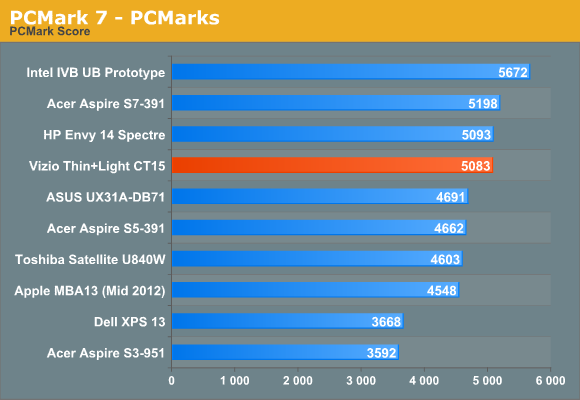
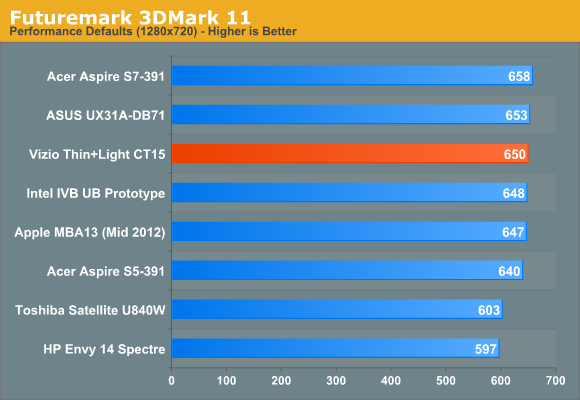
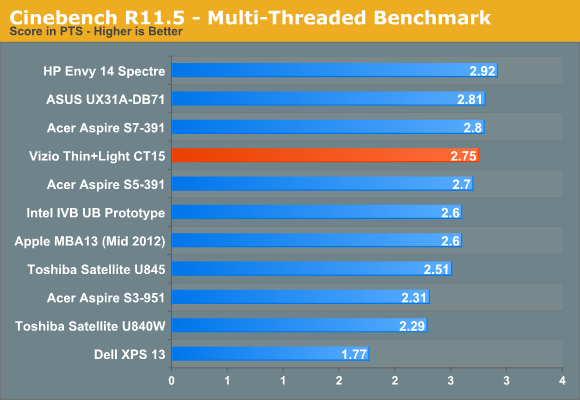
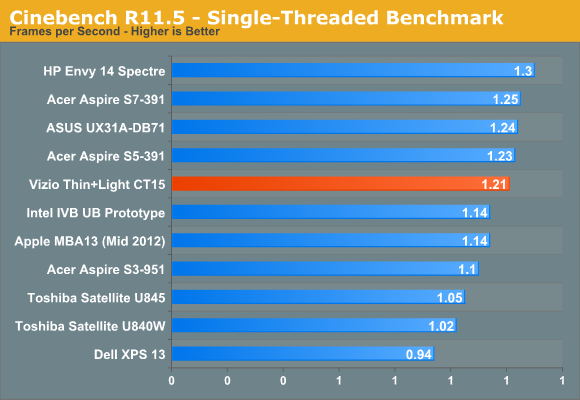
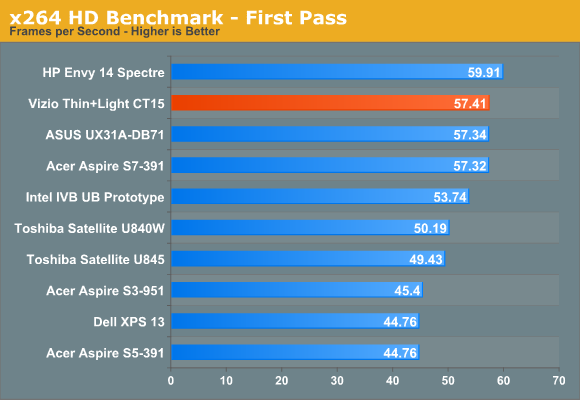
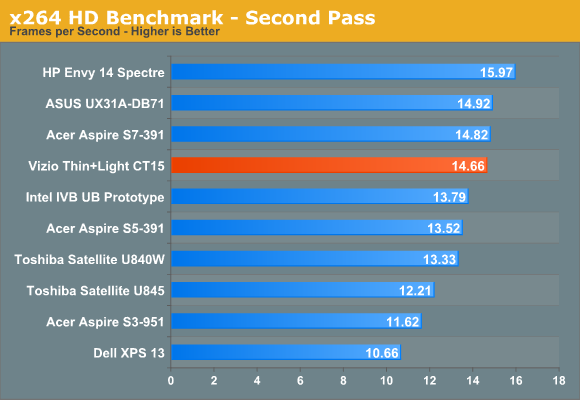
The CT15 has a 52Wh 6-cell li-poly battery that theoretically gives it decent battery life. Unfortunately, it doesn’t really hold up to that in real life, though you can point to a few reasons for that. We saw around five hours in our ideal case test and a hair over four in our internet test that tends to be a better barometer of what you can expect in typical daily use.
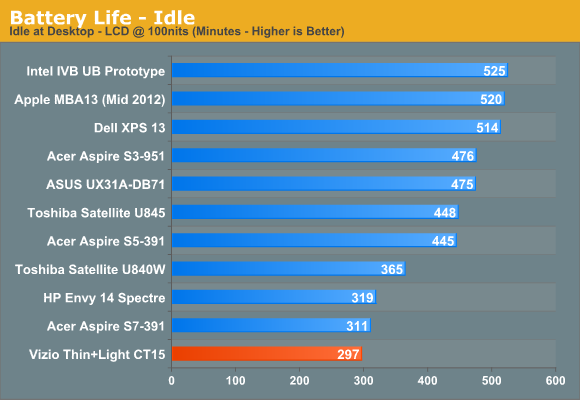
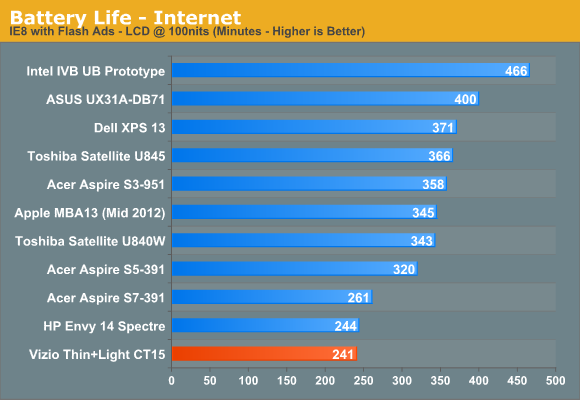

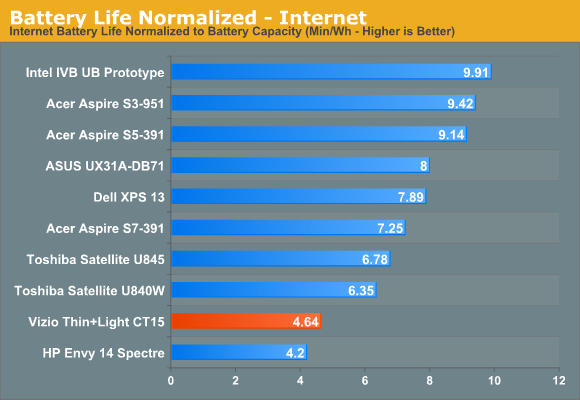
Those numbers seem low, as does the three hours and change in our HD video benchmark, but I think the main culprit is the 1080p 15.6” display. The increase in display size and resolution easily accounts for the increase in overall power draw compared to the 13” Ultrabooks we’ve seen thus far. Other than the Vizio and the HP Envy Spectre, every other notebook in the graphs is a 13” Ultrabook, which is why both the Vizio and the HP come off looking quite poor. Apple went with a 95Wh battery for the Retina MacBook Pro to end up at the 7 hour mark, versus 77.5Wh for the regular 15” MBP and 63.5Wh for the 13” (all three of which end up in the 7-8 hour range for battery life) so you can see how the 52Wh battery results in a relatively low runtime even with a ULV processor.
This issue gets fixed in the next-gen touchscreen Thin+Light, which has “nearly double” the capacity. I doubt it gets to the 100Wh mark, but even if it ends up near the 15” MacBook Pro in terms of capacity, it should be good enough for something along the lines of 6-7 hours of real world usage.










55 Comments
View All Comments
rangerdavid - Thursday, February 14, 2013 - link
Soldered-on is pretty standard in these thin form-factors. Yes, 6 or 8 would be nice, but removable means thicker in most cases. No pun intended. Wait, no; intended.blueboy11 - Friday, February 15, 2013 - link
LOL! Yeah, the damned soldered unremovable RAM that should've been upgraded to 8GB in the first place! What the hell where they thinking in the first place? Oh wait, they weren't!!MobiusStrip - Sunday, February 17, 2013 - link
Just because a rip-off has become standard doesn't mean we should accept it.Apple has led the way in degrading its computers with soldered-in RAM, glued-together chassis and now shitty laptop drives in its desktop computers. We should not give them or any other manufacturer a free pass on this crap.
PeteH - Wednesday, March 6, 2013 - link
I honestly don't think manufacturers are doing things like soldering down RAM to rip people off, I think they're doing it because that's the only way to get the form factor.The problem is that consumers continue to endorse trading flexibility for pretty industrial design (based on what they buy). Manufacturers are just giving the consumers what they want, and it's hard to fault them for it.
Ninhalem - Thursday, February 14, 2013 - link
When do you need more than 4 GB of RAM? If this is used as a non-gaming notebook I don't think you will ever need more than 4 GB for a regular notebook (the HD 4000 already guarantees that this isn't a gaming oriented notebook).I'm running a desktop at the moment with only 4 GB of RAM with about 5 applications open (including Adobe running a big file) and only using about 1.7 GB.
Actually this notebook is a slam dunk for me. I've been crawling the internet for a notebook with these specs for my father to use as a research (history) tool when he goes overseas.
I just don't think the perception of 4GB is not enough is viable here.
halo37253 - Thursday, February 14, 2013 - link
Tell me what you need more then 4gb of ram for?I have 6GB of RAM in my main system and have never had a program fill it other then p95 while stressing. Really unless the user is running VM crazy or is going crazy in some adobe program I think the user is more then set with 4gb.
RAM does not make your PC faster if you don't need it, no one using a laptop like this with no GPU to load advance compute or even games onto. Though even for gaming you don't need more then 4gb.
4GB in my gaming HTPC and 6GB in my main system, both always has RAM left.
I would rather have them take the 256gb SSD out of this laptop and toss in a 128gb m-sata chip and toss in a HDD for user storage. For SSD you only need some apps and OS on your SSD. Pretty much all user files in the c:\users\yourname can be moved onto the HDD for more storage. Do the same thing with my laptop and desktop, but with sata SSD not msata. No point to have movies, music, games installed onto the SSD.
themossie - Thursday, February 14, 2013 - link
Chrome can easily use more than 4 gigs of ram with a minimal set of extensions.6 gigs used right now (2 more cached) out of 8 gb on my old Arrandale Studio XPS 16. Notepad++ and two web browsers with 50 tabs open, flash disabled and minimal extensions.
How could I upgrade to a machine with less RAM? Many people can sacrifice processing power for battery life and form factor, but not RAM - especially given how cheap it is these days.
themossie - Friday, February 15, 2013 - link
Also - 4 years ago (early 2009), the entry-level config of the earliest version of my laptop (Core 2 Duo) came with 4 gigs of ram.It had the same $1100 MSRP at the time, though definitely not an ultrabook - weighing 2.5 lbs more:-)
seapeople - Sunday, February 17, 2013 - link
Browsers allocate far more memory than they actually use, and are programmed to trim this allocation with virtually no impact to performance once the memory is needed elsewhere in the system.So even though your Chrome may routinely report a use of 4-6 gb on your 8 gb system, if you only had a 4 gb system then Chrome would likely purr along just the same while using only 2-3 gb of RAM. Perhaps once every four days when you switch over to tab number 80 it will take 2 seconds for Chrome to pull up the picture at the bottom of the page on this tab, which you would only even notice if you switched to that tab and immediately hit Ctrl-End.
Not to mention that hibernating a system with 8 gb of RAM will take significantly longer than one with 4 gb of RAM...
cbf - Thursday, February 14, 2013 - link
Software Development.Visual Studio, local ASP.NET server (for debugging), and connection to large databases.
Also, certain CAD work. Normally one would say you need a workstation class laptop with Quadra or FirePro onboard, but frankly Intel HD4000 graphics is pretty close to where mobile Quadra or FirePro was a few years ago, and works OK with a lot of CAD packages now.